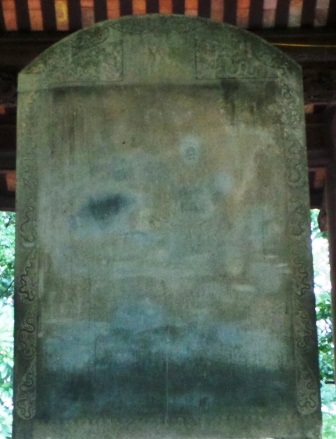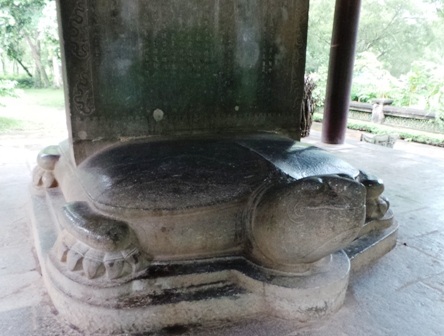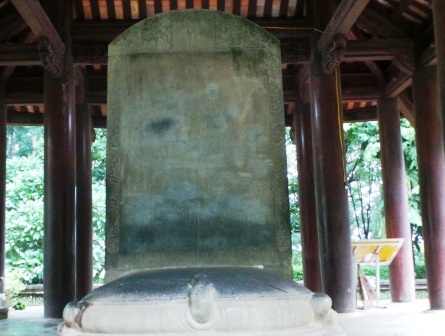Where the crystallization of values
Coming to Lam Kinh historical site, visitors cannot ignore Lam Son Vinh Lang Bi, also known as Vinh Lang Lam Son Beer (Vinh Lang Lam Kinh beer). Located about 300m southwest of King Le’s tomb, Vinh Lang stele is located southwest of Lam Kinh Main Palace.
The stele has a width of 1.94m, a height of 2.79m, and a thickness of 0.27m. Turtle is 3.46m long, 1.94m wide, 0.90m thick. Weight weighing about 18 tons was erected in the early 15th century (Thuan Thien year 6).
Beer and turtles are made of Sedimentary stone, gray-green color with white spots, glossy, on the surface of turtles and beer, many shells of mollusks can be seen.
The stele is rectangular in shape, placed on the back of a turtle, its forehead is arc-shaped, the center front is engraved with a square, in the square is a circle, in the middle of the circle is a 5-claw embossed dragon, on both sides of the stele’s forehead. The side is embossed with a dragon image and the inner circle has a coiled dragon with its head raised.

Around the edge of the stele, there are two parallel lines connecting from the top to the base of the stele, between the two lines, the inside is decorated with 9 patterns in the shape of half a leaf, in each half of the leaf is engraved a floating dragon. scales, soft winding body following the leaves, the dragon’s head reaching up to the top of the stele, the mouth releasing pearls, in the distance between the leaf shapes are carved alternately with chrysanthemum flowers …
The front of the stele is engraved with about 750 Chinese characters, the content of the stele is written in Chan, composed by the god Nguyen Trai. The full text records the tribe, date of death, life and career of King Le Thai To, important events that took place during the Lam Son uprising as well as when the country was independent and triumphed under King Le Thai To.
The back of the forehead is carved with a rectangular shape, on both sides is a dragon image, the body is long, smooth, without scales, winding, the head is raised, adoring. From the top of the stele’s forehead to the base of the stele, two lines are carved parallel to each other according to the height of the stele, between the lines, each side is engraved with 9 half-leaf patterns that follow each other from the top of the stele to the base of the stele…

Under the base of the target are turtles, turtles in a swimming position, with their heads raised, backs protruding, revealing 4 legs and 6 strong strong claws, out of which 6 nails are chiseled. The tortoise’s tail is large, upside down on the soft, curved back, the bottom of the turtle’s belly is close to the base, carved with 3 elaborate embossed edges, handcrafted techniques.
The stele is considered “unique”
Lam Kinh was originally Lam Son – the hometown of the national hero Le Loi, also the origin and first base of the Lam Son uprising against the Ming invaders in the 15th century. The uprising was won, Le Loi was crowned emperor, establishing the Later Le dynasty – the longest dynasty in Vietnam’s feudal history with 360 years.
In 1430, King Le Thai To changed Lam Son land to Tay Kinh (or Lam Kinh). From here Lam Kinh became the land of special attention of the Le kings.

In the leap year of the Ox year (1433), King Le Thai To died in Dong Kinh – Thang Long, was brought back to Lam Son’s hometown to be buried, built a mausoleum, and erected a stele at Vinh Lang. Also from here, the kings succeeded to build Lam Kinh to become a mountain mausoleum, where many kings and Thai Queen Thai Queen were buried in the Le So dynasty.
However, after nearly 6 centuries with many changes, ups and downs of history, along with the harshness of nature, Lam Kinh now has only 6 tombs and 5 steles left. Among the stele here, Vinh Lang stele of King Le Thai To is one of the typical stele typical of processing, erection, sculpting and carving techniques. Typical details represent the tombstones of the current Le So dynasty emperors in Lam Kinh in particular and the whole country in general.
Vinh Lang stele is also considered by cultural researchers as one of the biggest and most beautiful ancient steles in Vietnam.

The epitaph is short, concise, and fully describes the family, background, career and merits of King Le Thai To, and at the same time the epitaph is also a document summarizing the skillful way of fighting. love of Lam Son insurgent army during 10 years of long and arduous resistance war against the Ming invaders to regain independence for the nation.
Besides, it also speaks of the tolerance and generosity of the Thai To Cao Emperor Le Loi towards the enemy when they were defeated. The epitaph also tells us about King Le Thai To’s diplomacy towards neighboring countries – The path of peace diplomacy with his inherent kindness, goodwill, and peace.
Therefore, Vinh Lang stele not only has artistic value but also has historical textual meaning, historical evidence is the original document for traditional educational scientific research for posterity.
Vinh Lang stele is also a valuable document when studying decorative arts and sculpture in Vietnam under the Le So dynasty. Sculpture of Vinh Lang stele in the early Le Dynasty inherited the quintessence of sculpture from the Ly – Tran dynasties and the precious traditions of folk art.
Under the Le So dynasty, Confucian thought was highly promoted. Emperor Le Loi and his successors used Confucian doctrine as an ideological tool to run the country as well as build a national culture.

In the Confucian concept, the king is the son of heaven, replacing heaven to practice religion, and the dragon is a symbol of the king and of ultimate power. Besides the dragon image, Vinh Lang beer is also decorated with patterns such as chrysanthemums, leaves, water waves…
It can be said that Vinh Lang stele is considered a “unique” stele, it is not only traditional educational for posterity, but also a valuable document when studying decorative arts, sculpture under the Le So period.
Vinh Lang stele is the junction between the past and the later times, the opening point for a new development phase of the sculpture art, and undergoes continuous changes to arrive at the stele of King Le Thanh Tong and Queen Ngo Thi. Ngoc Giao has come to shape a complete new art style – Art of the Early Le Dynasty. With these typical values, Vinh Lang Lam Kinh beer has been recognized as a national treasure.
Source: Collected internet.